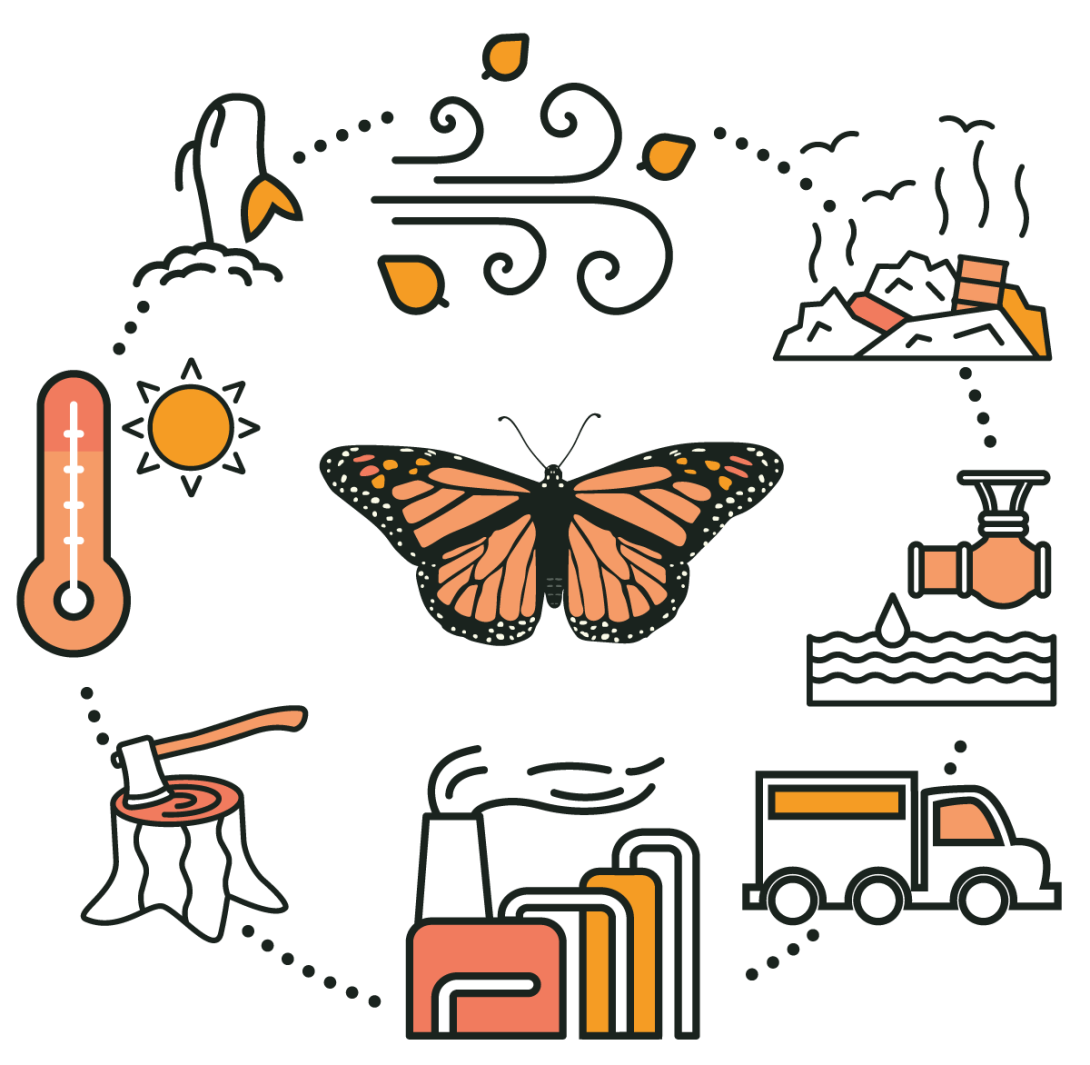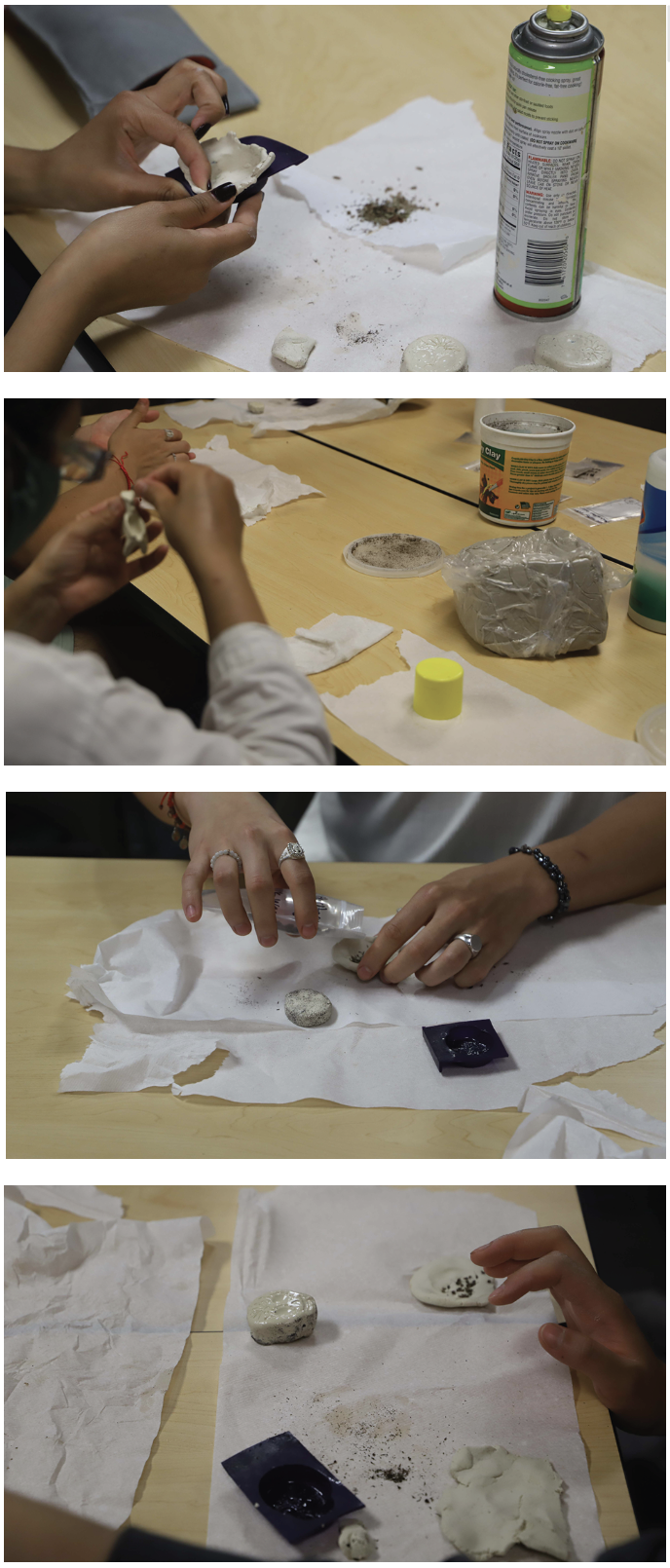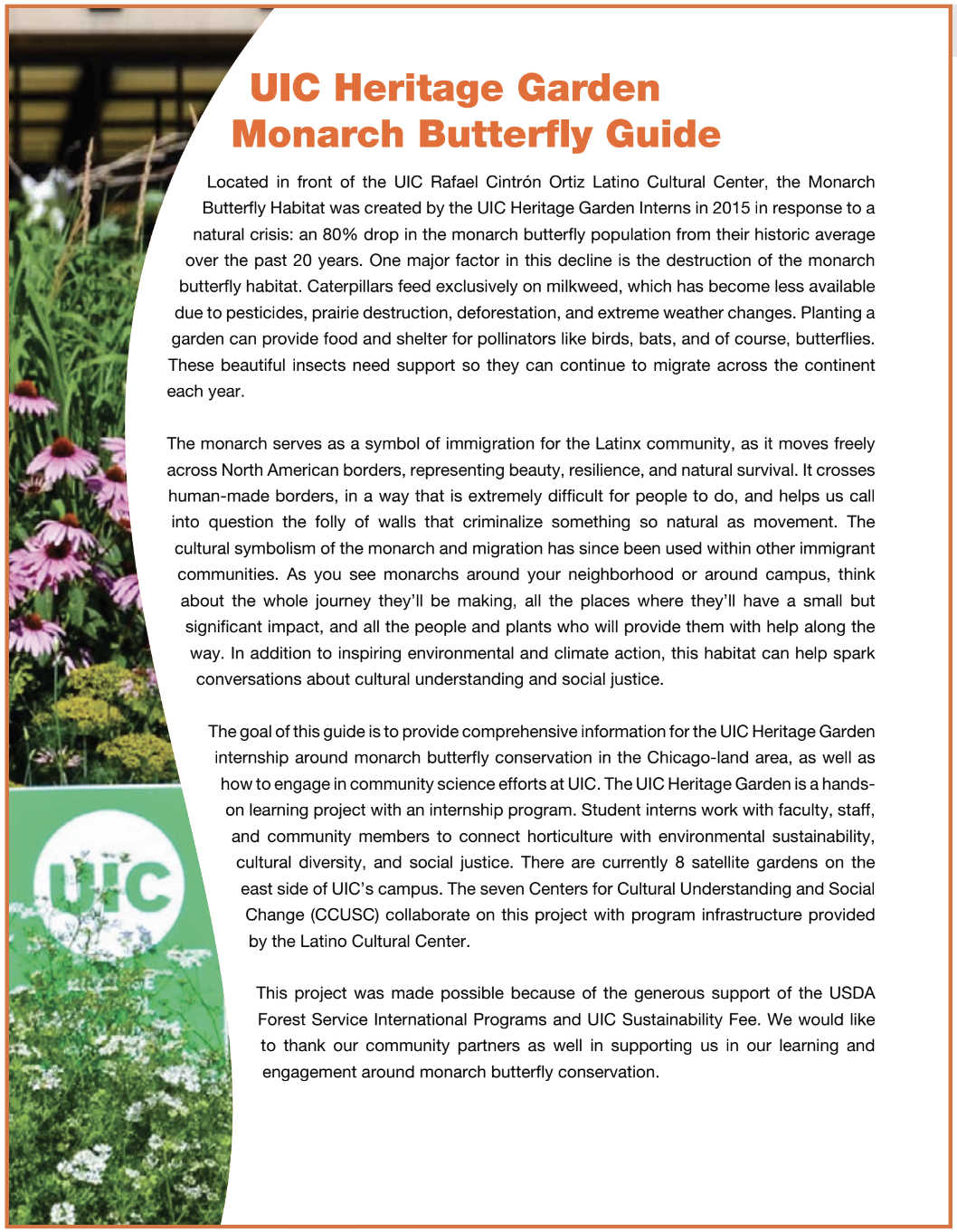Agents of Change
Themes: Environmental and climate (in)justice, monarch & conservation knowledge, and individual and collective assets.
Line

Activity 1: UIC Heritage Garden: Monarch Butterfly Kit
The UIC Heritage Garden is a hands-on learning project with an internship program for undergraduate students. Student interns work with faculty, staff, and community members to connect horticulture with environmental sustainability, cultural diversity, and social justice. The seven Centers for Cultural Understanding and Social Change (CCUSC) collaborate on this project with program infrastructure provided by the Latino Cultural Center. There are currently 8 satellite gardens on the east side of the UIC campus.
During the 2021-2022 academic year, the UIC Heritage Garden student leaders released a Monarch Butterfly Kit with several instructional and interactive components.
The Monarch Butterfly Guide includes details on Monarch Biology and Life Cycle, Monarch Migration, Monarch Stories and Cultural Connections, Common Monarchs Concerns (see below), and more. The larger Monarch Butterfly Kit includes various interactive components – Informational Cards with illustrations, a Monarch Band comic book, a Monarch Zine to highlight various cultural and communal ties to Monarch Butterflies, and more. These tools center the goal of engaging diverse audiences with ideas and actions of conservation, social justice, and
cultural diversity.
As the Heritage Garden student leaders note:
We, as the Heritage Garden, will continue to be part of the ongoing national and international advocacy for monarch and pollinator conservation and issues of environmental, climate and social justice. Our kit includes many features that aim to educate, highlight, and prompt change around the efforts of environmental conservation and social justice! We hope the resources found here, and on our website, help to provide a few figurative seeds to continue to build a world of abundance and care across generations, species and cultures.
monarch concerns

Common Monarch Concerns
In recent years, the southern migration of monarchs from North America has been delayed by as much as six weeks because of the warmer than normal temperatures. When the temperature begins to cool, it triggers the butterflies instinct to move south. Extreme weather events, like severe storms, can kill a large amount of overwintering monarchs in Mexico. In 2002, a severe storm killed around 80% of this population, a hit from which the species is still recovering. Hotter and drier weather can also negatively affect the larval stage of monarch development.
Climate change also impacts the plants and environments that the monarch depends on. The rising levels of carbon dioxide from car and factory exhaust has been linked to reducing the medicinal qualities of milkweed. Moreover, milkweed habitat loss has partially been from climate change, and climate models predict that the overwintering forests in Mexico may soon be no longer suitable for overwintering. The forests could be exposed to higher stress from heat and drought, which makes them more susceptible to insects and disease.
seed bombs

Seed Bombs
For this hands-on activity, participants get hands on experience and education around creating seed bombs. By combining clay, water, and soil to create seeds bombs, students are informed about how the seeds themselves can promote monarch butterfly habitats via guerrilla gardening. We make use of a sugar skull mold, to highlight the cultural connection and stories of Día de los Muertos with migration and the journey of the monarchs. However, students are encouraged to get creative as they shape and create their seed bombs. While not every seed bomb will result in a successful plant, some will survive as mature plants via this inexpensive activity.
Activity Note
The example shown on the left is of a sugar skull mold used for Dia de Muertos. Encourage students to shape their seed bombs into a shape that reminds them of monarchs and/or something that reminds them of their cultural heritage.
Materials required:
- Air-Dry Clay
- Seeds (milkweed variety)
- Potting Soil (any type)
- Water
- Toothpicks
- Molds for Clay *optional.
Directions:
- Pinch off a small piece of air dry clay – enough to shape into a 1-1.5” ball. Shape the clay into a small bowl. If using a mold, place the clay piece into the mold, leaving space for the seeds/soil mixture.
- In a bowl, combine your seeds and natural soil.
- Place a pinch of the seed/soil mixture into the clay bowl/mold. Use water to pinch the seed bomb closed.
- Allow the seed bombs to dry for 24 hours.
- Plant your seeds bombs by placing them around your neighborhood and watch your own milkweed garden grow!
monarch intro

Educator’s Note
As the Monarch Butterfly Guide & Kit provides extensive information and content to learn from and utilize, educators are encouraged to use the kit to generate activities that can help further conversation and knowledge on conservation, monarchs and milkweeds, and/or climate change in your classroom.
Line

Activity 2: Activating (Individual & Collective) Assets for Solutions
Every one of us has developed and acquired valuable assets – these can be skills, talents, or even resources within our network or community. It is through our individual and collective assets that
we can come up with creative and effective ideas and solutions for tackling inequalities and
climate change.
Definition: Environmental and Climate Justice (ECJ)
“… A local, grass-root, or ‘bottom-up’ community reaction to external threats to the health of the community that have been shown to disproportionately affect people of colour and low-income neighbourhoods.” (Agyeman, 2008)
Part 1
In this activity, participants are asked to think of assets that fall within three categories: Personal, Academic, and Community. After students fill out the Asset Mapping worksheet individually, ask them to discuss their assets with an assigned group. Each participant can then share one asset with the larger group to amass a list of collective group assets.
What do we mean by assets?
We recognize people’s assets as tangible and intangible. People with valuable skills and talents (like gardeners, community leaders, artists and writers, public speakers, researchers, fundraisers, or educators) can be identified by their tangible assets. Assets that are intangible include values (like frugality or a sense of global citizenship), traditions (like cultural festivals or rituals honoring the dead), and practices (like conserving water, growing your own food, recycling and repurposing, or sharing with neighbors), in addition to ideas and aspirations. By identifying participants’ tangible and intangible assets, participants are invited to imagine how each asset can be activated on its own or collectively to affect social change.
Reflective questions for Asset-Mapping:
- Personal: What are some of your personal/individual assets (talents/skills)?
- Academic: What are the assets that you have gained throughout your academic experience? How has your education expanded your existing assets?
- Community: Who has inspired or influenced you in your life (professionals, faculty, mentors, staff, peers, etc.)? What are some community resources or organizations that have served as assets for you?
Part 2
Once group assets have been identified and discussed, the students are asked to fill out the Exploring Environmental and Climate Challenges worksheet in small groups. This worksheet asks students to brainstorm a list of local, national, and global challenges that they are aware of. Once these challenges have been discussed, students will narrow down their list and choose one concern to focus on as they, collectively, design a solution using their assets as a starting point.
Activity 2
Our families, and at times ourselves, have experienced some form of (im)migration whether
that is through crossing international borders, moving between states, or from neighborhood to neighborhood.
The goal of this activity is for students to choose a family member from the past or present who has made their own im(migration) journey and can “be” a monarch butterfly whose journey the student’s reflect on.
Write a “Thank You” letter (personal message) to an ancestor while addressing/reflecting on the following questions:
- Who in your family comes to mind when you think of the monarch butterfly and its
migration journey? - What would you like the “monarch butterfly” in your family to know and what would you like to thank them for?
- How will you honor the memory of your ancestor based on the life you plan to live?
Activity Note
As an option, students can cut out paper monarchs to decorate using various art materials and write their response on the back of the faux butterflies. After the students have written their letter, encourage them to share which ancestor they selected to be their “monarch butterfly” and how they will continue to honor their ancestor.
Educator’s Note
Reiterate to students that as we conjure the symbol of the monarch butterfly to write a letter to an ancestor, that it is important to be inclusive of the variety of movement and experiences that their ancestors/themselves may have (moved once from city to city, across national borders, neighborhoods, etc.). Encourage students to draw inspiration from the movement of the natural world. Again, acknowledge that not all people have had the same agency or freedom of choice in their movement and thus our personal, family, or community experiences may differ.
asset mapping activity

Educator’s Note
Cultural and social backgrounds play a big role in shaping attitudes and beliefs about climate change, nature, and the environment. Be aware that “climate change” might be a challenging concept for some audiences. With any audience this activity can be a learning opportunity to gauge prior knowledge and build understanding together. During this activity, emphasize how different skills/assets can complement each other when considering local, attainable action steps and remind students that they have agency when responding to the collective challenges we face.